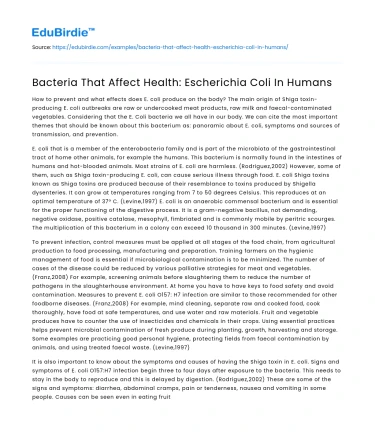How to prevent and what effects does E. coli produce on the body? The main origin of Shiga toxin-producing E. coli outbreaks are raw or undercooked meat products, raw milk and faecal-contaminated vegetables. Considering that the E. Coli bacteria we all have in our body. We can cite the most important themes that should be known about this bacterium as: panoramic about E. coli, symptoms and sources of transmission, and prevention.
E. coli that is a member of the enterobacteria family and is part of the microbiota of the gastrointestinal tract of home other animals, for example the humans. This bacterium is normally found in the intestines of humans and hot-blooded animals. Most strains of E. coli are harmless. (Rodriguez,2002) However, some of them, such as Shiga toxin-producing E. coli, can cause serious illness through food. E. coli Shiga toxins known as Shiga toxins are produced because of their resemblance to toxins produced by Shigella dysenteries. It can grow at temperatures ranging from 7 to 50 degrees Celsius. This reproduces at an optimal temperature of 37º C. (Levine,1997) E. coli is an anaerobic commensal bacterium and is essential for the proper functioning of the digestive process. It is a gram-negative bacillus, not demanding, negative oxidase, positive catalase, mesophyll, fimbriated and is commonly mobile by peritric scourges. The multiplication of this bacterium in a colony can exceed 10 thousand in 300 minutes. (Levine,1997)
Save your time!
We can take care of your essay
- Proper editing and formatting
- Free revision, title page, and bibliography
- Flexible prices and money-back guarantee
To prevent infection, control measures must be applied at all stages of the food chain, from agricultural production to food processing, manufacturing and preparation. Training farmers on the hygienic management of food is essential if microbiological contamination is to be minimized. The number of cases of the disease could be reduced by various palliative strategies for meat and vegetables. (Franz,2008) For example, screening animals before slaughtering them to reduce the number of pathogens in the slaughterhouse environment. At home you have to have keys to food safety and avoid contamination. Measures to prevent E. coli O157: H7 infection are similar to those recommended for other foodborne diseases. (Franz,2008) For example, mind cleaning, separate raw and cooked food, cook thoroughly, have food at safe temperatures, and use water and raw materials. Fruit and vegetable produces have to counter the use of insecticides and chemicals in their crops. Using essential practices helps prevent microbial contamination of fresh produce during planting, growth, harvesting and storage. Some examples are practicing good personal hygiene, protecting fields from faecal contamination by animals, and using treated faecal waste. (Levine,1997)
It is also important to know about the symptoms and causes of having the Shiga toxin in E. coli. Signs and symptoms of E. coli O157:H7 infection begin three to four days after exposure to the bacteria. This needs to stay in the body to reproduce and this is delayed by digestion. (Rodriguez,2002) These are some of the signs and symptoms: diarrhea, abdominal cramps, pain or tenderness, nausea and vomiting in some people. Causes can be seen even in eating fruits if the lack of hygiene is present. Unlike many other bacteria, E. coli can cause an infection even if you ingest small amounts. Landfills in the livestock industry can contaminate the fields where fresh fruits and vegetables are grown. Other potential sources of exposure are contaminated water and person-to-person contact. Human and animal faecal matter can contaminate soil and surface water. In addition, E. coli travels from one person to another, especially when not washing your hands well. Although water systems use chlorine, ultraviolet light, or ozone to kill E. coli, some outbreaks are related to contaminated water supplies. (Rodriguez,2002)
In conclusion, having the E. coli bacteria in our body and living day by day with it, does not allow us to be calm to get an infection. E. coli is very important for functioning of digestive system, but also it can produce several diseases.
SOURCES
- LEVINE, M.M. (1997). Eschrrickr di that cause diarrhea: enterotoxigenic. enteropathogenic, enteroinvasive. enterohemorrhagic, and enteroadherent. Enterobacteria Family. 7(5). 437-443. http://scielo.isciii.es/pdf/resp/v71n5/colaboracion.pdf
- MODRIC, L. (2000). E. coli concept. E. coli. 5(1). 210-212. http://www.efsa.europa.eu/sites/default/files/corporate_publications/files/factsheetecoli.pdf
- FRANZ, E. and A. H.C. (2008). Prevent E. coli. Life without E. coli. 6(5). 143-161. http://www.fao.org/fileadmin/user_upload/agns/pdf/Preventing_Ecoli_es.pdf
- RODRIGUEZ G. (2002). Efectos en la salud. Salud Pública de México.44(5). 464-475. http://www.adiveter.com/ftp_public/E.coli.pdf






 Stuck on your essay?
Stuck on your essay?

